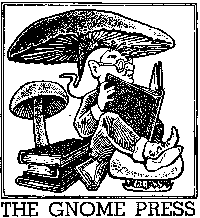
Gnome Press was an American small-press publishing company primarily known for publishing many science fiction classics. Gnome was one of the most eminent of the fan publishers of SF, producing 86 titles in its lifespan — many considered classic works of SF and Fantasy today. Gnome was important in the transitional period between Genre SF as a magazine phenomenon and its arrival in mass-market book publishing, but proved too underfunded to make the leap from fan-based publishing to the professional level. The company existed for just over a decade, ultimately failing due to inability to compete with major publishers who also started to publish science fiction. In its heyday, Gnome published many of the major SF authors, and in some cases, as with Robert E. Howard's Conan series and Isaac Asimov's Foundation series, was responsible for the manner in which their stories were collected into book form.

This is a bibliography of works by American writer John W. Campbell Jr.
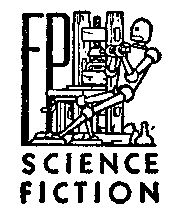
Fantasy Press was an American publishing house specialising in fantasy and science fiction titles. Established in 1946 by Lloyd Arthur Eshbach in Reading, Pennsylvania, it was most notable for publishing the works of authors such as Robert A. Heinlein and E. E. Smith. One of its more notable offerings was the Lensman series.

Lloyd Arthur Eshbach was an American science fiction fan, publisher and writer, secular and religious publisher, and minister.
Everett Franklin Bleiler was an American editor, bibliographer, and scholar of science fiction, detective fiction, and fantasy literature. In the late 1940s and early 1950s, he co-edited the first "year's best" series of science fiction anthologies, and his Checklist of Fantastic Literature has been called "the foundation of modern SF bibliography". Among his other scholarly works are two Hugo Award–nominated volumes concerning early science fiction—Science-Fiction: The Early Years and Science-Fiction: The Gernsback Years—and the massive Guide to Supernatural Fiction.

The Legion of Space is a science fiction novel by the American writer Jack Williamson. It was originally serialized in Astounding Stories in 1934, then published in book form by Fantasy Press in 1947 in an edition of 2,970 copies. A magazine-sized reprint was issued by Galaxy in 1950, with a standard paperback following from Pyramid Books in 1967. The first British edition was published by Sphere Books in 1977. The Legion of Space has been translated into German, French, Italian and Japanese . It has also appeared in the omnibus Three from the Legion, which compiles the novel and all but one of its sequels.
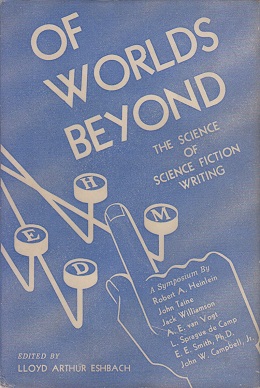
Of Worlds Beyond is a collection of essays about the techniques of writing science fiction, edited by Lloyd Arthur Eshbach. It was first published in 1947 by Fantasy Press in an edition of 1,262 copies. It has been reprinted by Advent in 1964 and by Dobson in 1965.

Triplanetary is a science fiction novel and space opera by American writer E. E. Smith. It was first serialized in the magazine Amazing Stories in 1934. After the original four novels of the Lensman series were published, Smith expanded and reworked Triplanetary into the first of two prequels for the series. The fix-up novel Triplanetary was published in book form in 1948 by Fantasy Press. The second prequel, First Lensman, was a new original novel published in 1950 by Fantasy Press.

The Incredible Planet is a science fiction fix-up novel by American author John W. Campbell, Jr. It was published in 1949 by Fantasy Press in an edition of 3,998 copies. The novel is a collection of three linked novelettes that were not accepted for the magazine Astounding SF. The stories are sequels to Campbell's 1934 novel The Mightiest Machine.

The Bridge of Light is a science fiction novel by American writer A. Hyatt Verrill. It was originally published in the Fall 1929 edition of the pulp magazine Amazing Stories Quarterly. It was subsequently republished in book form in 1950 by Fantasy Press in an edition of 2,556 copies.

The Moon Is Hell! is a collection of two stories, one science fiction, the other sword and sorcery, by American writer John W. Campbell Jr. It was published in 1951 by Fantasy Press in an edition of 4,206 copies. The title story, published for the first time in this collection, deals with a team of scientists stranded on the Moon when their spacecraft crashes, and how they use their combined skills and knowledge to survive until rescue, including building shelter from meteor showers, and creating their own oxygen from Lunar rock. The second story, "The Elder Gods", Campbell rewrote, on a short deadline, from a story by Arthur J. Burks purchased for Unknown but later deemed unsatisfactory. It originally appeared in the October 1939 issue of Unknown under the pseudonym Don A. Stuart. The title of the eponymous story is occasionally found without the exclamation point, but the punctuation is used for the title of most editions of the collection itself.

The Black Star Passes is a fixup of science fiction short stories by American author John W. Campbell Jr. It was first published in 1953 by Fantasy Press in an edition of 2,951 copies. The book is the first in Campbell's Arcot, Morey and Wade series, and is followed by the novels Islands of Space and Invaders from the Infinite. The stories originally appeared in the magazines Amazing Stories and Amazing Stories Quarterly, and were "extensively edited" for book publication, with Campbell's approval, by Lloyd Arthur Eshbach.
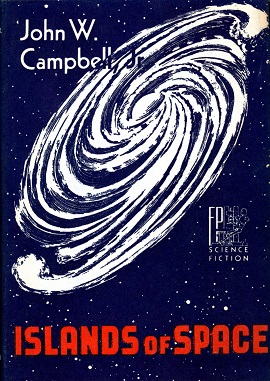
Islands of Space is a science fiction novel by American writer John W. Campbell Jr. It was first published in book form in 1957 by Fantasy Press in an edition of 1,417 copies. The novel originally appeared in the magazine Amazing Stories Quarterly; the text was "extensively edited" for book publication, with Campbell's approval, by Lloyd Arthur Eshbach. A paperback edition was published by Ace Books in 1966. In 1973, Islands was included in a Doubleday omnibus of all three "Arcot, Wade, and Morey" novels. A German translation appeared in 1967 as Kosmische Kreuzfahrt, and an Italian translation was published in 1976 as Isole nello spazio.

The Heads of Cerberus is a science fiction novel by American writer Francis Stevens. The novel was originally serialized in the pulp magazine The Thrill Book in 1919, and it was first published in book form in 1952 by Polaris Press in an edition of 1,563 copies. It was the first book published by Polaris Press. A scholarly reprint edition was issued by Arno Press in 1978, and a mass market paperback by Carroll & Graf in 1984.
Grant-Hadley Enterprises was the first of three names used by an American small press publishing house specializing in science fiction titles. The company was founded in 1945 by Donald M. Grant and Thomas G. Hadley and published one title as Grant-Hadley Enterprises. Kenneth J. Krueger joined the company in 1946 and the name was changed to The Buffalo Book Company. Later in 1946, Hadley continued the company on his own as The Hadley Publishing Co.

The Mightiest Machine is a science fiction novel by American writer John W. Campbell, Jr. The novel was originally serialized in 5 parts in Astounding Stories magazine from December 1934 to April 1935, and was published in book form in 1947 by The Hadley Publishing Co. in an edition of 1,200 copies. Campbell was a leading figure in the Golden Age of Science Fiction.
Shasta Publishers was a science fiction and fantasy small press specialty publishing house founded in 1947 by Erle Melvin Korshak, T. E. Dikty, and Mark Reinsberg, who were all science fiction fans from the Chicago area. The name of the press was suggested by Reinsberg in remembrance of a summer job that he and Korshak had held at Mount Shasta.
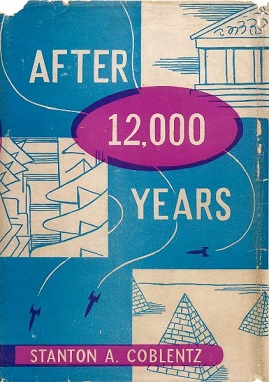
After 12,000 Years is a science fiction novel by American writer Stanton A. Coblentz. It was first published in book form in 1950 by Fantasy Publishing Company, Inc. (FPCI) in an edition of 1,000 copies, of which 750 were hardback. Lloyd Arthur Eshbach regarded this as one of the stronger titles published by FPCI. Considered one of the author's most bizarre and most interesting futuristic fantasies, the novel originally appeared in the Spring 1929 issue of the magazine Amazing Stories Quarterly. The novel was abridged for the FPCI publication. E. F. Bleiler considered the unabridged version to be superior.

Drome is a fantasy novel written and illustrated by John Martin Leahy. Originally serialized in the magazine Weird Tales in five parts beginning January 1927, it was first published in book form in 1952 by Fantasy Publishing Company, Inc. in an edition of 1,000 copies.
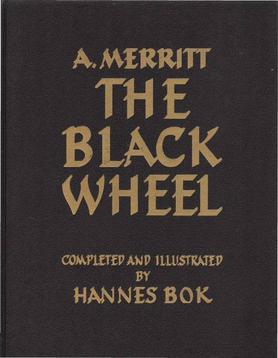
The Black Wheel is a fantasy novel by American writers A. Merritt and Hannes Bok. Merritt had completed the first seven chapters, roughly 20,000 words, before his death in 1943. Bok wrote the remainder of the novel, twenty chapters of more than 60,000 words, working from "a sketchy plot outline" left by Merritt. The story concerns the discovery of a centuries-old shipwreck, complete with the preserved bodies of its crew, and the consequences for the passengers and crew of the cruise ship that comes across it.


















